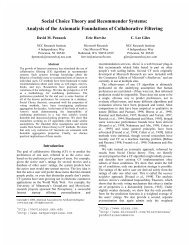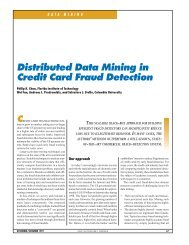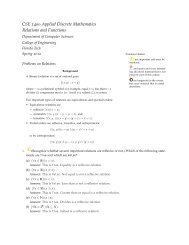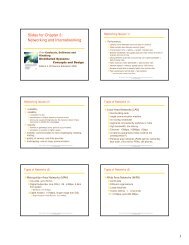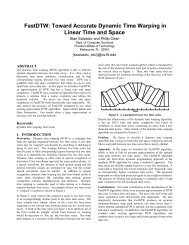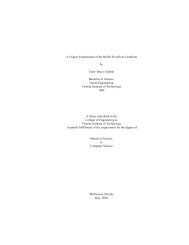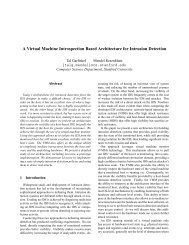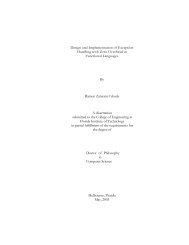Integration of Topological Constraints in Medical ... - Florent Ségonne
Integration of Topological Constraints in Medical ... - Florent Ségonne
Integration of Topological Constraints in Medical ... - Florent Ségonne
You also want an ePaper? Increase the reach of your titles
YUMPU automatically turns print PDFs into web optimized ePapers that Google loves.
10 F. Ségonne and B. Fischl<br />
each cubic cell is processed sequentially. Patches (i.e. sets <strong>of</strong> triangles) that<br />
approximate the isosurface (based on tri-l<strong>in</strong>ear <strong>in</strong>terpolation) are produced<br />
with<strong>in</strong> each cube, and the polygon patches are naturally jo<strong>in</strong>ed together to<br />
form the f<strong>in</strong>al isosurface representation.<br />
Unfortunately, the standard march<strong>in</strong>g squares or march<strong>in</strong>g cubes algorithm<br />
does not generate topologically consistent tessellations, s<strong>in</strong>ce the<br />
result<strong>in</strong>g tessellations may conta<strong>in</strong> til<strong>in</strong>g and topological <strong>in</strong>consistencies<br />
(Fig. 5-b). In order to alleviate this problem, Han et al. [28] have designed<br />
a modified connectivity-consistent march<strong>in</strong>g contour algorithm, by build<strong>in</strong>g<br />
a specialized case table for each type <strong>of</strong> digital topology (Fig. 5-c).<br />
Extensive discussion <strong>of</strong> isocontour extraction algorithms can be found <strong>in</strong><br />
the thesis <strong>of</strong> Han [25]. Note also some new research directions such as [1].<br />
3 State <strong>of</strong> the Art <strong>in</strong> Segmentation under<br />
<strong>Topological</strong> <strong>Constra<strong>in</strong>ts</strong><br />
As noted previously, methods for produc<strong>in</strong>g topologically-correct segmentations<br />
can be broadly divided <strong>in</strong>to two categories. A first set <strong>of</strong> approaches<br />
directly <strong>in</strong>corporates topological constra<strong>in</strong>ts <strong>in</strong>to the segmentation process,<br />
while another set aims at correct<strong>in</strong>g retrospectively the spherical topology<br />
<strong>of</strong> an already segmented image.<br />
3.1 <strong>Topological</strong>ly-Constra<strong>in</strong>ed Segmentations<br />
The topology-enforc<strong>in</strong>g techniques proceed by iteratively deform<strong>in</strong>g a model<br />
<strong>of</strong> known topology onto a targeted structure, while preserv<strong>in</strong>g its topology.<br />
Several techniques have been used for the segmentation <strong>of</strong> anatomical structures,<br />
with the topological constra<strong>in</strong>t tak<strong>in</strong>g different forms depend<strong>in</strong>g on<br />
the chosen method.<br />
A - Active Contours<br />
Depend<strong>in</strong>g on the representation, two different implementations are usually<br />
encountered. One encodes the manifold <strong>of</strong> <strong>in</strong>terest with an explicit<br />
representation us<strong>in</strong>g a Lagrangian formulation [52], while another implicitly<br />
represents the contour as the level set <strong>of</strong> a function def<strong>in</strong>ed on higherdimensional<br />
manifold <strong>in</strong> an Eulerian formulation [9, 40].<br />
• Parameterized models ma<strong>in</strong>ta<strong>in</strong> an explicit representation <strong>of</strong> the contour<br />
and preserve its <strong>in</strong>itial <strong>in</strong>tr<strong>in</strong>sic topology. Any level <strong>of</strong> accuracy can<br />
be achieved by us<strong>in</strong>g more ref<strong>in</strong>ed meshes. However, the preservation <strong>of</strong><br />
the whole topology also requires the prevention <strong>of</strong> self-<strong>in</strong>tersections, which<br />
proves to be computationally <strong>in</strong>tensive and requires elaborate methods to<br />
detect and prevent surface <strong>in</strong>tersection dur<strong>in</strong>g the evolution. Also, note that<br />
the preservation <strong>of</strong> the <strong>in</strong>itial topology is <strong>of</strong>ten a strong limitation to most



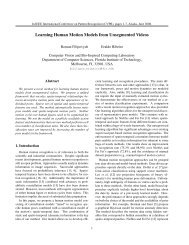
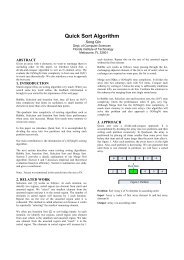
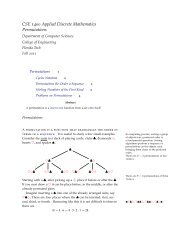
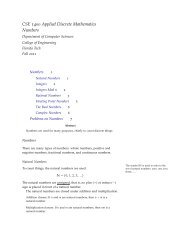
![{ public static void main (String[] args) { System.out.println (](https://img.yumpu.com/49719541/1/190x143/-public-static-void-main-string-args-systemoutprintln-hello-.jpg?quality=85)
